Frederic Remington Art How to Draw a Horse Step by Step
Using visual observation, illustrations, and words, students compare and contrast two horse art objects, the Han dynasty Horse and Frederic Remington'due south The Cheyenne.
Intended Age Group
Early childhood (ages 3-5)
Standards Area
Language Arts
Lesson Length
I 25 minute lesson
Objectives
Students will be able to:
- communicate their thoughts and visual observations nigh the two fine art objects;
- interact with their peers when listening to others and talking about the art objects;
- work on the pronunciation and spelling of the word "equus caballus;" and
- explain their analogy of a horse.
Lesson
- Get-go, innovate the Han dynasty Horse and Frederic Remington's The Cheyenne. Bring attention to how the artists made these objects and reference points of involvement from the About the Art sections.
- Prompt children to employ their visual observation skills and share what they meet. Ask students the post-obit questions: Do you accept an idea of the materials used to make the objects? Do the objects look similar real horses? Can y'all depict what the horses are doing?
- While looking at the art objects also refer to images of existent horses. Point to the word "horse" often and spell it a few times. Encourage the class to follow along every bit you say and spell "horse."
- Explain that together students will develop a list of words that depict things that are the aforementioned virtually each horse. Write these words or phrases on the lath. Review the listing one time it is consummate.
- Challenge children to make a list of all the differences they tin can find. Again, write this on the board and review.
- Have children illustrate their version of a horse. Refer to the two art objects and the other horse images. Encourage children to think about how they are going to draw their horse by referring to the similarities and differences they establish when looking at the two art objects.
- Once they take completed their horse drawing, accept them write the word "horse" by post-obit forth equally y'all slowly spell and indicate to each letter.
- Review some of the words in the similarities/differences lists and enquire students to pick one or ii favorite words from the listing to re-create onto their illustration.
Materials
- Whiteboard and markers
- Images of horses to be passed around or posted in the classroom
- Enlarged word "equus caballus" to be posted on the board during the lesson
- Arrow tool
- Paper and pencil for horse illustration
- Nigh the Fine art sections on the Han dynasty Horse and Frederic Remington's The Cheyenne
- One color re-create of the Han dynasty Horse and one color re-create of Frederic Remington's The Cheyenne for every four students, or the ability to projection the images onto a wall or screen
Standards
CO Standards
- Visual Arts
- Invent and Discover to Create
- Detect and Learn to Comprehend
- Language Arts
- Oral Expression and Listening
- Writing and Composition
- Reading for All Purposes
21st Century Skills
- Collaboration
- Critical Thinking & Reasoning
- Information Literacy
- Invention
- Self-Management
The Cheyenne
Model Date: 1901, Cast Appointment: 1903
Artist
- Frederic Remington, American, 1861-1909
Manufacturer
- Roman Bronze Works
Nearly the Creative person
Frederic Remington was born in County, New York, and attended the Yale Schoolhouse of Art, where he studied drawing and played football. When he was twenty years old, he traveled west for a holiday and mailed a rough sketch to Harper'due south Weekly magazine, kicking off his career as an illustrator. He had tried his hand at sheep ranching in Kansas, but subsequently a couple of years returned to New York, making trips west from his home in the East. Almost of his work was created in his studio in New Rochelle, New York. Remington's artistic career began with painting and cartoon, simply a friend encouraged him to try his mitt at sculpture in 1895. He fabricated 24 sculptures in his terminal xiv years every bit an creative person. Remington liked the permanence of bronze sculpture: "My water colors volition fade—just I am to endure in statuary," he said. He died at age 48 at the height of his career.
What Inspired Information technology
Remington felt compelled to record an American Westward that he believed to exist disappearing. He loved to portray the action and energy of the Due west and did not feel confined by what were considered the limits of the bronze medium. In this sculpture, Remington has defied the traditional ways of supporting sculpture, making the falling robe a part of the activity. The equus caballus and rider are full of energy and appear to be moving apace. Remington often worked from photographs to achieve this authentic image of movement. To create this bronze sculpture, Remington used a method called lost wax casting. A "cast" is a form that is created by pouring liquid metal into a mold. Although it is over 6000 years erstwhile, the lost wax method had been newly introduced in the United States during Remington's time. The procedure involves vi dissimilar steps—during each step a new model of the sculpture is made. Lost wax casting allows the artist to brand quick changes and fine-tune the wax model earlier each cascade. Remington took advantage of this opportunity for experimentation, and often visited the foundry that produced his casts at this phase. His boosted artistic input is evident in the Denver Art Museum'south sculpture, peculiarly in the textures and color of the slice.
Details
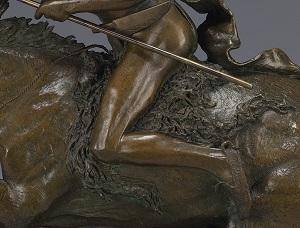
Different Textures
Compare the polish skin of the Indian to the rippled musculature of the horse's flank to the high relief texture of the buffalo robe. This sculpture shows the texture variation that was possible using the lost wax method, and it is evidence that this cast received a great bargain of personal attending from the artist.
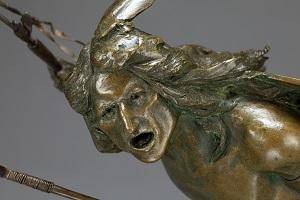
Color
The golden dear color of this particular cast is much lighter than other casts of The Cheyenne, which may be prove that Remington himself was involved in selecting it. He usually preferred a blue-black patina, so this was probably an experiment.

Four Hooves Off the Basis
In 1878, Eadweard Muybridge's (MY-bridge) photos of racehorses in motion proved that all four hooves leave the footing at one time. Wanting to testify this in bronze, Remington added a buffalo robe falling toward the basis as a back up for the flight horse.
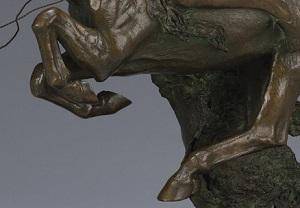
Authentic Leg Position
Muybridge's photos also revealed another misconception: in their off-the-ground position, the horse'south legs were bunched together under the belly, rather than in the "hobbyhorse attitude," with forepart legs stretched frontward and hind legs backward, which was traditional in painting. In using this pose for The Cheyenne, Remington was 1 of the showtime artists to take advantage of this new information.
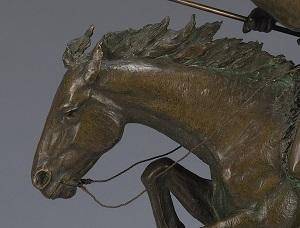
Mane & Tail
The horse'southward mane and tail add to the sculpture's sense of motion—they appear to be blown back past the wind.
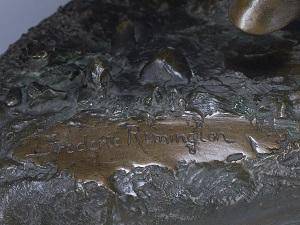
The Artist's Signature
Remington's signature changes location from cast to cast. On ours, it appears on the base.
Funding for object education resource provided by a grant from the Morgridge Family unit Foundation. Boosted funding provided by the William Randolph Hearst Endowment for Didactics Programs, and Xcel Energy Foundation. Nosotros thank our colleagues at the University of Denver Morgridge College of Education.
The images on this page are intended for classroom use simply and may not be reproduced for other reasons without the permission of the Denver Art Museum. This object may non currently exist on brandish at the museum.
Source: https://www.denverartmuseum.org/es/node/10188

